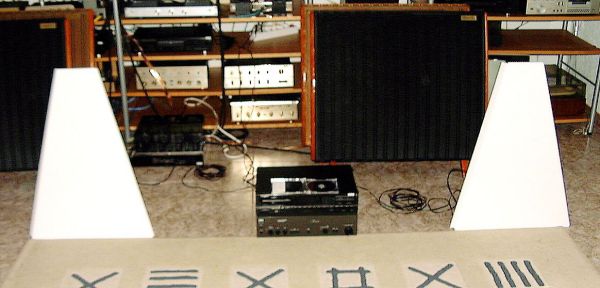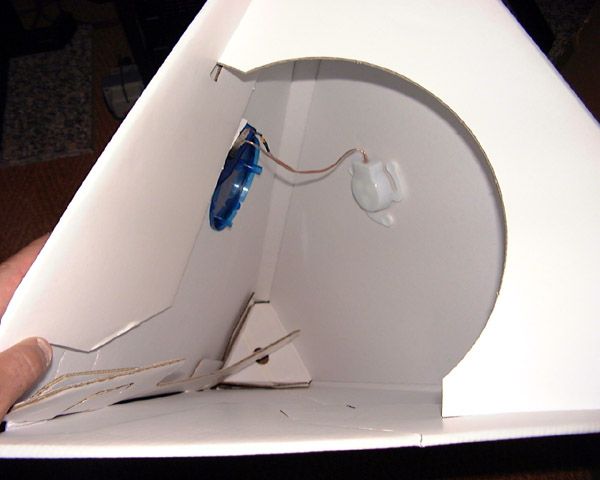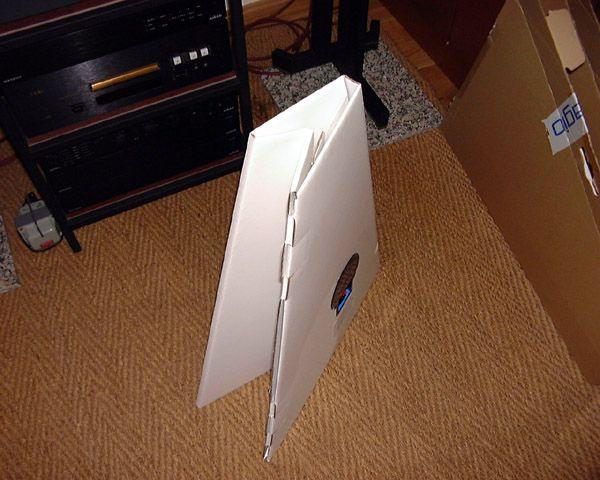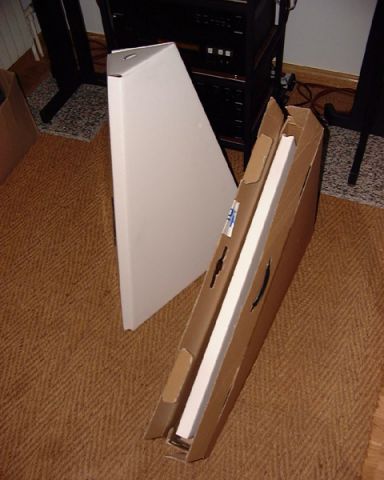
| [ SoundPax NXT Loudspeakers] |

In 1997 I read some articles in the british hi-fi magazines about a new technology of planar loudspeakers called NXT. In these days the Verity Group, that then included hi-fi brands like Mission, Cyrus and Quad created a company named New Transducers Ltd, NXT, with the main objetive of develope, sell and license the new planar speaker technology discovered during a series of experiments done by the Defence Evaluation and Research Agency (DERA) of the british goverment. Seeing the new technology, I tried to continue reading and learning about it during the following years. More articles appeared in the magazines and even some test of speakers using the new technology. Also at the last edition of Sonimag (the spanish hi-fi and consumer electronics show) I saw some (shy) examples of these speakers. The following years more news about applications of these speakers came to the ligth, but none of them were in hi-fi. There were news about the use of NXT technolgy in other fields like multimedia, computers, etc. Because I'm not interested in these themes, I almost forgot NXT, but at the end of 2001 I read again an article about the use of NXT technology in hi-fi. The article I'm talking about explained that a new pair of speakers using NXT panels were introduced in the market. They were made with cardboard and they could be purchased at the web site of a company called Amina. I wrote to Amina because I wanted to order a pair of these speakers but they told me that they only sold the speakers in the UK. So I forgot the theme until some weeks ago when I discovered that there was a spanish distributor, Adagio, for these speakers. I went to one of the shops that Adagio has in my city and I purchased the SoundPax speakers. I was very curious about them and the technology they use and I couldn't wait more time to test by myself the qualities of these speakers. That is what I have done and so I have written these lines to explain my experience.
First, let's see how and when the NXT technology appeared and where it goes. As I said before the british army agency DERA took during the many years some experiments about soundproving helicopters using a specially designed panels. The surprise of the technical staff at DERA was really great when they found that the panels didn't absord the sound of the aircraft. In fact they produced more sound, the panels acted as speakers. As you can see the birth of a hi-fi techcnolgy was the result of some unwanted effects from an investigation doesn't related to hi-fi. Collateral effects? With these new technology in their hands the people of DERA tried to found a company interested in these experiments and so DERA contacted Verity. Verity had all the knowledge in the audio field needed to continue the experiments, to improve the technology in order to develop a new family of planar speakers. And that was what Verity did. They founded a new company called NXT to do all these things. After seeing that the new technology was something really great, Verity sold some of the hi-fi brands they had and focused all their attention in NXT. During all these years the company has been researching about the new technology (visit their web site and you will see all the articles and patents they have), developing it in order to improve the new planar speakers and to offer new products and applications fields for them. The results of all these research efforts are new materials to use in the building process of the panels. These materials have differents properties and they can be used in many differents situations. For example they have now completely transparent panels that can be used in computers monitors, tv screens of cellular phones displays (so, the screen itself will sound!), panels to use in automovile industry that will replace traditional speakers, panels for roofs or panels that look like paintings to hang on the wall. In the hi-fi field the use of NXT is reduced to few examples. If I'm not wrong, a floorstand model, the sounding paintings, and the Soundpax model. As you can see there're a great number of fields where to use the NXT panels. This is the true value of the technology, its potential. NXT has undestood this and its main activity has been to license the technology to a big number of companys. I think that in a near future wee will see the NXT panels and technology used in many fields.
Now let's see how a NXT panel works. The secret of the NXT is in the building process of the panels itself. They are like sandwich panels made with several layers of differents materials selected after many test and comparisons with the objetive to get the best audio quality from them. The panels are the key of the system. They produce the sound when are excited by an "exciter" (in NXT words. In the SoundPax model, the exciter is a neomidyum magnet and a coil). What is really curious about the NXT panels is the behaviour of the speakers because it is incoherent. In conventional speakers the cones act in a coherent mode, that is, the whole cone push or pull at the same time. In the NXT the panel moves in an incoherent way. This means that some parts of the panel are pushing and other parts are pulling at the same time. This incoherence gives a very "particular" sound signature, mainly in terms of sound dispersion that is difuse. This dispersion in very useful when the panels are used in other fields different to pure hi-fi, because the sounstage is wider and the sound preassure is maintained at a distance between 4 and 5 meters away from the speakers. But, as you know this is not good for hi-fi because due to the "dispersion" it is difficult to get a focused soundstage, an accurate stereo image,etc. Maybe these drawbacks in the hi-fi use of the panels are the reason why we don't see more speakers with the NXT technology available for pure hi-fi use.

The SoundPax model we're talking about is a "for fun" application of the NXT panel technology. The speaker is not intended for pure audiophile use, but to be used when a musical atmosphere is needed, for example to play some music in a party. The SoundPax are designed with this goal in mind and that's why they're made of cardboard. In addition they can be bend to ease the transport. The idea behind these speakers is to give to the user a simple unit, easy to use, to transport, etc. I must say that they're very funny and always a surprise for the people who sees a unit like this for the first time. If we have in mind these concepts we must admit that the SoundPax are really great. But, if we take the SoundPax to the audiophile arena? That's what I have done.


For this purpose I have matched the Soundpax whit a NAD 3240PE and a Philips CD630 CD player. I have used this two components because I think that these are two pieces that could be owned by non audiophiles, the ideal public for the SoundPax. I started the test and the first surprise was that the SounPax can sound. Let me explain myself. When you see and speaker without cones, made with cardboarb and with a little plastic piece inside (that contains the magnet and the coil) the first surprise is that they could sound. And, well, I like surprises. All the surface of the frontal side of the pyramid emits sounds, and also the other sides does the same but at lower level. Let's see with details how they sounded.
With treble frequencies the speakers sounded sometimes agressive and a little bit fatiguing. Voices were silibants and due to this I used the tone controls of the amplifier to reduce in more than a point the treble to compensate the excess and to get a more friendly behaviour. This was the same solution that the people at the shop where I purchased the speakers were using. With less treble the sound was less agressive but also something was missing. I have read in some articles available in the net about these speakers that this problem with the treble softens with use.
With bass the SoundPax showed the general problems of planar speakers (yes, I know they are not real planar, but almost). The bass lacked impact and sounded thin. The extension is limited and so a subwoofer would help a lot (NXT use a subwoofer with the panels that look like paintings to compensate this). I have to use again the tone controls to get more bass. I even tried the Bass EQ system of the del NAD and even the loudness but the result were worse (not due speakers, but to the bass enhacements systems themselves. I don't like them).
Maybe the most important problem, in addition to the described above, is the stereophonic image. It was difficult to get a clear stereo image from the speakers during all the audition. There was a stereo balance (sound coming from left and from rigth) but the central image was not well defined. The sound was difuse, maybe as a result of the incoherent behaviour of the speakers, and the image was unfocused. On the other hand, this difussion helped to mantain an almost constant sound preassure when I was walking in the room at a distance of 4 or 5 meters away from the speakers. That's the reason why these speakers are good for creating musical atmospheres, etc.
More curious things. If the volume is too loud the little plastic spider attached to the inside of the speaker (the one that contains the magnet and the coil) vibrates. Also the speaker
switch off automatically if the sound is too loud (it is a protection system of the exciter). The speakers moves (jumping) while playing loud music. It is better to fix them to the floor using, for example, Blu-Tack.
In conclusion, in pure audiophile uses don't expect too much from the SoundPax. They are designed for other uses different to critical listening. They're are not bad but they have limitations if you try to use in a pure hi-fi environment. The objective of the SoundPax is to produce the described musical atmosphere. I can imagine these speakers been used in a contemporary art exposition while the people walks looking at the paintings and wondering who is the sculptor that has made these pyramids. Talking again about the NXT technology. I think that it will be a great success (it is). Just imagine tv screens, computer monitors and celullar phones displays sounding. Or even NXT panels as a part of a conventional speakers or in a AV instalation (that use could be great) . Don't doubt about it, the NXT technology is a step further in audio reproduction. Maybe it doesn't fit audiophiles requeriments but it is great for a huge number of different fields. And maybe in a future, with the background on audio that NXT has, also in high fidelity.